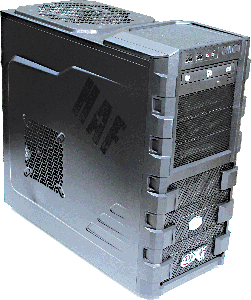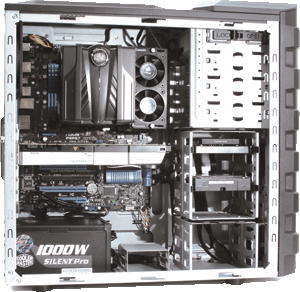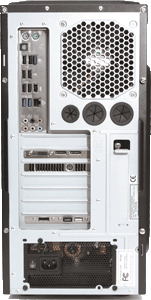Review: Xi MTower PCIe Workstation Provides More Bang for the Buck
The over-clocked Xi MTower PCIe Workstation from @Xi Computer delivers fantastic price and performance.
Latest News
December 4, 2001
By David Cohn
 The Xi MTower PCIe workstation is housed in a Cooler Master HAF 912 case with four front panel bays and six internal drive bays. The perforated grills in the top and side aid cooling, but don’t help muffle internal fan noise. Photo courtesy of David Cohn. |
California-based @Xi Computer Corp. (pronounced “at-ex-eye”) has been building workstations since May 1992. At one time, I even owned one. Yet I couldn’t remember the last time I reviewed one of the company’s computers.
Needless to say, I was quite interested when DE received one of @Xi’s latest Intel-based workstations, the Xi MTower PCIe—powered by a 3.4GHz Intel Core i7 2600K quad-core CPU. That processor, based on Intel’s newest Sandy Bridge architecture, has a maximum turbo frequency of 3.8Ghz.
Sandy Bridge brings the memory controller and PCIe controller onto the CPU die, and also includes on-board graphics, although CAD and DCC users will still want to equip their systems with a discrete workstation-class graphics accelerator. The Core i7 2600K also incorporates an 8MB SmartCache.
But the big news is that the “K” in the CPU’s name means that the chip has an unlocked multiplier, making it easier to overclock this processor. That’s just what @Xi did, boosting the system to 4.1GHz.
The Xi MTower PCIe came housed in an HAF 912 case manufactured by Cooler Master. The charcoal gray tower measured 8.6x19.4x18.0 in.; the system weighed 33 lbs. A small panel at the top of the front bezel contained a pair of USB ports, microphone and headphone jacks, and both a power and separate reset button. Below this were four 5.25-in. drive bays with front-panel access. The top-most bay contained an 18X Liteon dual-layer DVD+/-RW drive.
Some Assembly Required
When we first removed the workstation from its packaging, a note warned that before powering the computer on for the first time, we needed to open the case to remove spacers that were installed inside to absorb shocks during shipping. The left panel of the Cooler Master case was held in place by two non-captive thumbscrews. After removing these and putting them safely aside so they wouldn’t get lost, we opened the case and removed three foam rubber blocks.
| Design Engineering Workstations Compared. Download the benchmarks. |
The Intel Core i7 2600K CPU requires a larger heat sink and fan than earlier processors. Because the CPU in the MTower was overclocked, rather than use Intel’s thermal solution, @Xi included a Cooler Master V6 GT heat sink. This 5-in., cube-shaped device with two large fans mounts on top of the processor, completely hiding it from view. It was this contraption that the foam blocks were supporting during shipping.
@Xi assembles its systems from standard components, and includes all of the manuals and extra nuts, bolts, etc., that come with those parts. When we unpacked the MTower, residing among all of the spare parts and cables was a box containing a Corsair AIRFLOW memory cooling fan, along with yet another note informing us that we needed to go to a link on the @Xi website to watch a video explaining how to assemble and install this component. The resulting installation process took just a few minutes, but the device really didn’t attach very firmly to the memory sockets.
Room for Expansion
Inside the well-organized case, we had easy access to the six internal drive bays, one of which contained the system’s boot drive: a 120GB Corsair Force Series F120 solid-state hard drive. This 2.5-in. form factor device has a maximum read speed of 285MB/second, and a lifespan rated at more than 1 million hours mean time between failures. A second bay held a Western Digital 1TB 7200rpm SATA hard drive for use as a data drive. This still left lots of space for us to add additional storage. A Cooler Master SilentProM 1,000 watt power supply was tucked neatly into the bottom rear corner of the case, and provides ample power for future additions.
 Inside the Xi workstation, a large Cooler Master heat sink conceals the over-clocked Intel Core i7 2600K CPU (upper left), while the Corsair fan unit that we had to assemble and mount to its right cools the system memory concealed beneath. Photo courtesy of David Cohn. |
The new Intel Sandy Bridge processors cannot be plugged into the same LGA1156 socket used for Intel’s last generation of “Westmere” family CPUs, but rather requires the new LGA1155 socket. For that reason, the Xi MTower PCIe was assembled around an ASUS P8P67 motherboard with an Intel P67 Express chipset. The ASUS motherboard provided a total of seven expansion slots: one PCIe X16 slot (x16 electrically), a second X16 slot (x4 electrically), a pair of PCIe X1 slots, and three PCI slots. One PCIe X16 in our evaluation unit was filled with an NVIDIA Quadro 5000 graphics accelerator, a double-width board that covered the adjacent PCIe X1 slot. @Xi also offers a range of other graphics accelerators from both ATI and NVIDIA. With 352 GPU cores and 2.5GB of GDDR5 video memory, the Quadro 5000 also requires auxiliary power.
The ASUS motherboard also provides four dual in-line memory module (DIMM) sockets, and supports up to 32GB of system memory using 8GB DIMMs. Our evaluation unit came with 16GB of RAM, installed as four 4GB 1,333MHz DDR3 DIMMs. The motherboard also supports up to eight SATA drives and includes a Realtek 8111E Gigabit LAN controller, a Bluetooth v2.1 controller, a Realtek 8-channel high-definition audio CODEC with DTS surround sound and jack-detection/retasking, an on-board IEEE 1394 controller supporting up to two FireWire ports, and an NEC USB 3.0 controller—in addition to the USB 2.0 support built into the Intel P67 chipset.
All of this on-board support was put to good use, as the rear panel offered PS/2 mouse and PS/2 keyboard ports, an optical S/PDIF out port, Bluetooth module, eight USB 2.0 ports, two USB 3.0 ports, an IEEE 1394a port, an RJ45 LAN port, and six audio ports—including line-in, line-out/front speaker out, microphone, center/subwoofer, rear speaker out, and side speaker out providing support for 2-, 4-, 6- or 8-channel audio configurations. The NVIDIA Quadro 5000 graphics card has one DVI-I connection, plus two DisplayPorts.
Remarkable Performance
Thanks to the solid-state hard drive, it took less than 30 seconds from the time we powered up the Xi MTower PCIe workstation until Windows 7 was ready for us to start working.
Although the MTower was equipped with the same NVIDIA Quadro 5000 as the systems we’ve recently tested from BOXX and Dell, it had just a single quad-core CPU compared to the dual six-core CPUs in the Dell T5500 and 3DBOXX 8550XTREME workstations. While we were expecting to see decent performance, particularly since the Intel Core i7 2600K processor in the MTower was over-clocked to nearly the same speed as the Intel Xeon X5680 in the BOXX workstation, we didn’t expect the MTower to set any records.
Boy, were we surprised.
On the SPECviewperf test, which focuses solely on graphics performance, the Xi MTower managed to set new high-water marks for three of the eight datasets in the test, and ranked close to the top on several others.
Unfortunately, @Xi did not provide us with a dual-boot system, so we were unable to obtain a complete set of valid result for the SPECapc SolidWorks benchmark. This test breaks out the graphics, CPU and I/O performance separately from the overall score. While we couldn’t use the overall or graphics scores, the CPU and I/O results were, again, right near the top.
It was only when we turned our attention to our own AutoCAD rendering test, which clearly shows the advantages of hyper-threading, that the Xi MTower PCIe workstation lagged behind. Because it had the equivalent of only 8 CPU cores with hyper-threading enabled, compared to 24 on the BOXX and Dell workstations, it took nearly 50 seconds to complete the test rendering. Still, that proved to be the best results we’ve ever recorded for a system with a single quad-core CPU.
Because the MTower had an over-clocked CPU, @Xi made sure the system had lots of cooling. We counted no fewer than eight fans: one in the front panel and one on the rear, two in the large Cooler Master CPU heat sink, two more in the Corsair memory cooling module, one in the power supply and one in the NVIDIA Quadro 5000. Although the system was relatively quiet when idling, once we started running our tests, we could definitely hear all of those fans. With a large perforated grill in the top and a second in the removable side panel, the Cooler Master HAF 912 case provides little acoustic control.
 The ASUS P8P67 motherboard provides a host of on-board features, enabling lots of rear panel connections and plenty of expandability. Photo courtesy of David Cohn. |
Our evaluation unit came with Windows 7 Professional Edition 64-bit pre-installed, and @Xi included the actual Microsoft DVD and certificate of authenticity. Other versions of Windows and several flavors of Linux are also available. In fact, you can choose from a wide range of options on the @Xi website. For example, our evaluation unit came with a wonderful Logitech cordless desktop MK710 keyboard and matching laser mouse, which added $95. The standard @Xi warranty only covers the system for one year, in spite of the fact that many of the systems’ components have longer warranty periods if purchased separately. For an additional charge, @Xi offers warranties of up to four years, as well as on-site service.
Although the base price for the Xi MTower PCIe workstation is just $1,119, we expected the cost of our evaluation unit to be much higher. The NVIDIA Quadro 5000 alone added $1,999 to the price. But at $4,465 for the system as tested, the Xi MTower PCIe delivers more bang for the buck than any other system we’ve tested recently.
For More Information: @Xi Computer Corp.
Xi MTower PCIe workstation
- Price: $4,465 as tested ($1,119 base price)
System Requirements
- Size: 8.6x19.4x18.0-in. (WxDxH) tower
- Weight: 33 lbs.
- CPU: one Intel Core i7 2600K (quad-core) 3.4GHz (over-clocked to 4.1GHz)
- Memory: 16GB DDR3 ECC at 1333MHz (up to 32GB supported)
- Graphics: NVIDIA Quadro 5000 (one DVI port, two DisplayPorts)
- Hard Disk: Corsair Force Series 120GB solid-state SATA drive, Western Digital 1TB SATA 7,200rpm drive
- Optical: Liteon 18X DVD+/-RW Dual-Layer
- Audio: on-board integrated high-definition audio (microphone and headphone on front panel; optical S/PDIF out, line-in, line-out/front speakers, microphone, center/subwoofer, rear speakers, and side speakers on rear panel)
- Network: integrated 10/100/1000 LAN with one RJ45 socket
- Other: PS/2 keyboard, PS/2 mouse, two USB 2.0 on front panel, eight USB 2.0 on rear panel, two USB 3.0 on rear panel, one IEEE 1394a on rear panel, Bluetooth module on rear panel
- Keyboard: 105-key Logitech MK710 cordless keyboard
- Pointing device: Logitech M705 laser mouse
David Cohn is the technical publishing manager at 4D Technologies. He’s a contributing editor to Desktop Engineering and also does consulting and technical writing from his home in Bellingham, WA. The author of more than a dozen books has been benchmarking PCs since 1984. You can contact him via email at [email protected] or visit DSCohn.com.
Subscribe to our FREE magazine, FREE email newsletters or both!
Latest News
About the Author
David Cohn is a consultant and technical writer based in Bellingham, WA, and has been benchmarking PCs since 1984. He is a Contributing Editor to Digital Engineering, the former senior content manager at 4D Technologies, and the author of more than a dozen books. Email at [email protected] or visit his website at www.dscohn.com.
Follow DE





